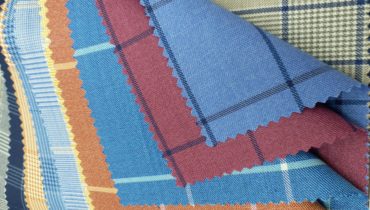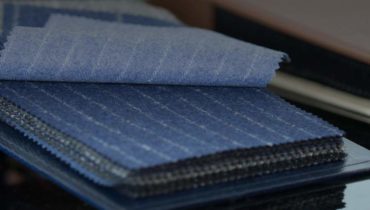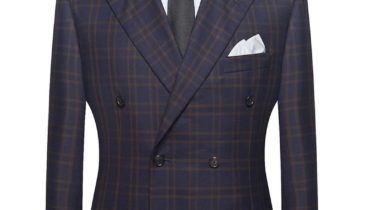For most young guys setting out to look sharp, figuring out exactly how to buy your first suit can be a little overwhelming. There is a seemingly endless array of options available, to say nothing of all the questions to ask and decisions you have to make. And much like one of life’s other memorable firsts, it can be easy for guys to overthink it and put way too much pressure on themselves — after all, you never forget your first time suit. But unlike that other pursuit, buying your first suit is one endeavor in which extensive – ahem – “internet research” can actually make you look like a pro your very first time. In this post I’ll lay out everything you need to know about how to buy your first suit and outline some straightforward steps you can follow to find the perfect kit to fit your body, budget and style.
What to look for in your first suit
How much you need to spend
Where to get it
How to make sure it fits like a glove
How to make yourself and your new suit stand out from the crowd so with the foreplay officially over, let’s dive in and unpack exactly how to buy your first suit
For suiting up in Style
Step 1: Define its Purpose how-to-buy-your-first-suit-bond before you can even start to think about what to buy, make sure you have defined why you are buying it in the first place. Answering a few simple questions about your suit now, before the process has even started, will ensure you buy the one that suits your needs. (Yes, that was a suit pun. And yes, I am the worst.) A few key questions to ask yourself include: Do you want to wear it year-round, or just during one season (i.e. only during summer or only during winter)? Are you mostly wearing it to weddings and other social functions, or for work/business?
Do you expect to wear it once or twice a year, or more like once or twice a week? Do you plan to wear the pieces separately (i.e. wear the jacket as a blazer or wear the pants without it)? Jot your answers down in order to really entrench them in your mind and keep yourself laser-focused on what you need. Depending on where you go to buy a suit (much more on that below) you may find that salespeople try to push you in one direction or another. Having a clear idea of exactly what you want will make you less likely to be led astray by a sales clerk who’s more concerned with making a sale than meeting your needs.
Stylish, Versatile, Affordable Since you’re obviously wondering how to buy your first suit, I’m going to assume that you have a lot in common with most first-time suit buyers.
Which means you probably…
Want a suit you can wear year-round
Want something you can wear to both social and business functions
Expect it to wear it roughly six times a year (for weddings, job interviews, funerals, etc.)
Might need to wear it more often (depending on your job)
Might want to wear the pieces separately the rest of this post will be geared toward these assumptions, but if your needs differ significantly, feel free to email us with any specific questions.
Opt for a good, multi-purpose suit that you can wear year-round to any occasion that calls for something a little spiffier than a blazer.
Step 2: Set a Budget How much are you willing to spend? How-to-buy-yours-first-suit-budget As noted philosopher Kanye West once so gloriously tweeted, “Suits is an expensive addiction.” Buying a suit is not unlike other, more grammatically correct addictions: when getting your first fix you can either opt for the lower-end cheap stuff, the most prime product, or something in between. It all depends on your personal preference. And your budget.
Price is equal Quality
When learning how to buy your first suit, one of the biggest early hurdles is figuring out exactly how much you need to drop. It’s important to remember that the most expensive suits are not necessarily the best. There are lots of other factors that better indicate a suit’s quality. How-to-buy-yours-first-suit-material how does your suit fit? What material is it made of? These things matter as much as (if not more than) price.
Things to Consider:
Fit (much more on that below)
Material
Is it lightweight, heavy or in between?
Is it shiny or matte?
Does it look cheap?
Does it feel like cloth, or like it has some kind of light plastic coating?
Craftsmanship
Is it fused, full canvas or half canvas?
Style
Does it have notched or peak lapels? And how wide are they?
Does it have an extra ticket pocket?
Does it look classic and evergreen, or modern and trendy?
Fortunately, thanks to the explosion of the menswear industry over the past few years, there are now more options than ever for a suit that meets all of your criteria without breaking the bank.
A Word of Warning: Don’t Go Too Cheap it’s definitely possible to get a well-made, good-quality suit for a few hundred bucks, but I’d be very wary of any suit. Better to invest a couple hundred now in a suit you can wear for years to come than to spend a quick hundreds on a piece of crap that’s going to rip, wrinkle or go out of style in the next several months. For your first suit, I’d recommend something in the $350 to $600 range. Even at the low end of this range, you should be able to find a suit that you can wear for years (and maybe even decades), without having to choose between suiting’s up or paying your rent.
Step 3: Get Measured
How-to-buy-your-first-suit-measured alluded to this above, but it’s worth repeating. No matter what budget you’ve set for yourself, there’s one factor – above all others – that determines how good a suit looks: How it fits. I’ve seen very rich men wear very expensive suits that look like total crap. And I’ve seen fiscally challenged men wear inexpensive suits that make them look like movie stars. With suits, as with all clothing, fit trumps price. So before you decide which suit to buy, you want to make sure you’ve got an accurate set of measurements to work from. There are two ways to find your measurements.
- Go to a Tailor
By far the best and most accurate way to get measured for a suit is to simply head into any tailor or suit store and ask to get measured up.
- Do it Yourself \
It’s a little tricky, but if you’ve got a measuring tape, it can be done. We have a great little tutorial, complete with illustrations, laying out exactly how to do it.
Step 4: Picky Any Color You Want
This may be the most controversial thing I say in this entire post: Your first suit should absolutely be navy blue. I know, I know. There are dozens if not hundreds of other perfectly viable colors out there. And yes, I’ve heard all the arguments in favor of grey, that other stalwart of a man’s wardrobe. But for your first suit, there’s simply no more classic, versatile or sophisticated choice than navy.
Classic:
Color trends come and go pretty quickly in the fashion world, but navy blue is always in style, always masculine, and it works with any complexion.
Versatile:
A navy suit looks sharp in literally any setting, from weddings and funerals to job interviews and corporate functions.
Sophisticated:
James Bond wears navy suits. Need I say more? (Come to think of it, I probably should have led with that.) In addition to all of that, the dark hue is much more forgiving when it comes to stains, dirt or other grime, meaning that you can wear the hell out of it and not feel like you need to run to the dry cleaner after every wear. Hopefully I’ve convinced you that navy is definitely the way to go for your first suit, but if for some reason you’re still entertaining other colors, I certainly won’t judge you. (Unless you go with black.)
Step 5: Choose Between Custom Made or Off-the-Rack
How-to-buy-your’s-first-suit-rack since choosing the color is really no choice at all, this is where you’re going to have to make your first real decision: do you want to buy a suit off the rack or have one custom made just for you? Let’s define each option and then break down the pros and cons.
Off-the-Rack
What is an Off-the-Rack suit?
An off-the-rack suit is one that you literally take off a rack in a clothing store (or order online). How does it work?
It’s pre-made according to standard suit sizes, which use your chest size as a rough approximation for the size of your body.
So if you’re trying to decide which off-the-rack suit to try on, you’d take a look at the measurements you (or your tailor) took earlier. If your chest size says 40, you’d go for a 40 suit in one of the three fit options. If you’re shorter than 5’6” you’ll want a 40-short, or 40S. If you’re 5’7” to 5’11” you’ll want a 40-regular, or 40R. And if you’re 6’ or up you’ll want a 40-long, or 40L.
Pros:
Price
Off-the-rack suits are generally a much more affordable option when compared with custom made ones, which are usually more expensive. How-to-buy-yours-first-suit-rack-of-suits Availability
It’s easy to find an off-the-rack suit. The menswear department at any department store will be packed full of ‘em, as will stores you can find in aliababmart.com.
Cons:
Imprecise Fit
It’s very rare to find an off-the-rack suit that fits like a glove. Instead, what’s more likely to happen is that you’ll find a suit that fits you in the chest and shoulders, but is a little bit off in terms of sleeve length, waist size or pants. If you choose the right size off-the-rack, a good tailor should be able to make some tweaks so that it fits you (almost) perfectly, but you’ll have to factor that cost into the overall price of the suit.
Quality
Don’t get me wrong: many off-the-rack suits are exceptionally well made. But because they’re often mass-produced, some are going to be cheaply assembled. If you decide to opt for something off-the-rack, choosing the right brand will be crucial (more on that later).
Generic Styling
Because you’re choosing a suit that’s already been manufactured, you have no control or input into details like the color, material, lapel style, button stance, etc. All you can do is sift through the racks to find one that you like. (But to be fair, there are so many options out there that this usually isn’t a problem.)
Custom Made
What is a custom made suit? A custom made suit (also called a Bespoke or Made to Measure suit) is exactly what its name implies: a suit custom made just for you, to your exact specifications and preferences.
How does it work?
You visit a suit maker, who measures you even more thoroughly than your tailor would. They’ll ask you questions about every facet of the suit’s style and fit: what kind of lapels do you want? What kind of fabric? How many pockets? How long do you want the jacket? And so on. They then go off and cut the fabric of your choice into a pattern tailored just for you. The end result is a one-of-a-kind suit that’s specifically made to fit you perfectly.
Pros:
Perfect Fit (obviously)
There are other reasons to get a custom suit, but this is the main one. A man never looks better than when he’s decked out in a custom kit made just for him.
Quality
Custom suits are usually made with high-quality fabrics and a great attention to detail. As a result, they not only look great on their intended wearer, but can last a lifetime if properly cared for.
It’s Classy as Shit.
People who have custom suits made include James Bond and Harvey Specter. And yes, two of those people are fictional. But they could both kick my candy ass – and look dapper as shit while they’re at it.
Cons:
Price
To paraphrase an old adage: there’s always a catch – and the catch is usually money. A custom suit will fit you perfectly and meet all of your criteria for the perfect suit, but you’ll pay for the pleasure.
Scarcity of Sources
While it’s easy to wander into a mall and find a ton of great off-the-rack options, it’s a lot harder to find a good suit maker who will craft something custom for you. But, harder doesn’t mean impossible. Brands like kahntailors.com (more on them below) have popped up over the past few years to make custom suits more widely available.
Step 6: Choose a Store/Brand
As I mentioned earlier, the world of menswear has exploded over the past few years. So if you’re wondering not just how to buy your first suit, but where, the good news is you have a ton of options to choose from. The bad news is you have a ton of options to choose from. After all, some psychologists have argued that increased consumer choice can lead to anxiety and paralysis by analysis. Suiting up should be fun, not nauseating. So to make your decision more manageable, let’s review a few of the most popular stores and brands that sell stylish, well made and (mostly) affordable suits.
Step 7: Invest in Yourself
Keep in mind that you’re not just buying something, you’re making an investment. You want to buy something you can wear for years to come, so taking the time to do your due diligence now is worthwhile. Plus, once you’ve surveyed the landscape and have a feel for what you like, buying your second suit becomes a hell of a lot easier. Love that first blue Napoli suit you bought from us? They also make it in multiple shades of gray, any of which might be right for your next kit.
Step 8: Pull the Trigger!
You’ve got your measurements, you’ve surveyed the landscape and you’ve even tried on multiple options. It’s time to pull the trigger and buy your first suit! Of course, just because you’ve made the purchase doesn’t mean you’re ready to step out in your suit just yet…
Step 9: Get it Tailored
If you’ve read this far, this one won’t come as much of a surprise. Assuming you stuck with my advice and bought a suit off the rack, you’ll definitely want to get it tailored. (If you sprung for a custom made suit than it should fit like a glove by the time you take it out of the store. Congrats! Now move on to step 10 to find out how to make it look even better.) The exact tailoring your suit needs will obviously depend on you, your body and your new suit, but here are a few of the most common alterations you’ll want to consider
Sleeve Length
A perfect fitting suit says, “I’m confident and in command.” A suit with sleeves that are too long says “I borrowed this from my dad.” When your arms are hanging straight at your sides, you want the suit to reveal about ¼ to ½ an inch of shirt cuff (assuming your shirt fits properly, of course). Go any shorter than that, and the suit might say, “I borrowed this from my kid brother,” which is also not what you’re going for.
WARNING: Do not let your tailor pressure you into leaving the sleeves long. (Actually, don’t let him pressure you into anything.) Most tailors are from another generation (i.e. old guys) and have very different impressions of how your suit should fit. Know what you want going in, explain it clearly and have them repeat it back to you. Be polite, but firm. You just dropped half a grand on this thing, and you want to make sure you’re getting the final product you want.
Pant Length
Again, you want to get this right so you neither look like you’re drowning in fabric nor preparing for a (handsome-ass) flood. If you read GQ or other men’s fashion magazines, you might have noticed that the modern style is to keep the pant legs cropped pretty short and show a lot of sock (or bare ankle, weather permitting). This looks great on some guys, but it can be a bit tricky to pull off without looking like you spontaneously went through an overnight growth spurt. If you want to play it a bit more conservative, tell your tailor you want about ¾ of an inch of “break.” The break is the part of your pant leg that crinkles a bit when it touches the top of your shoe. You definitely don’t want to overdo it, but leaving just a little extra fabric will allow you to cross your legs without treating your wedding date or potential employer to that gnarly scar on your shin.
Jacket Waist/Midsection
You should be able to find a jacket that fits pretty well across the chest and shoulders based on your measurements. But depending on how trim you are through the middle, you might find that the waist needs to be taken in a little bit. As a general rule, when the top button of your suit is done up, you want to be able to fit your closed fist between the button and your stomach. Leave any more room than that and you’ll find that the silhouette of your jacket looks too boxy. Any less and, well…
Pant Waist
If you opt for one of the brands above that sells suit separates, you should be able to find a fit off the rack that hugs your hips and butt appropriately. But occasionally a little nipping and tucking is needed, particularly if you want to go beltless. And just in case this doesn’t go without saying: it’s easier to take pants that are a little too loose in, than it is to let tight pants out out. If you’re concerned about having room where it counts, consider sizing up when buying, then have your tailor take them down to a comfortable level. (He can always let them back out again later if you add a little heft.)
Step 10: Accessorize
OK, so you’ve got a suit that fits like a glove and you’re ready to strike out on the town. There’s just one problem: you can’t exactly pair your new suit with your Nikes and your gym clothes. (I mean, you could, but… please don’t.) You’re definitely going to want a shirt and tie, and maybe a few more accessories to take your look to the next level. One of the many great things about a navy blue suit is that it can be accessorized in about a thousand different ways. But to help get you started, here are a few recommendations that you can combine for an overall look that’s modern, classic and, as they say on London’s Saville Row, classy as shit.
Shirts
A shirt isn’t really an accessory — it’s a necessity — which also makes it the best place to start. With a navy blue suit, you really can’t beat a crisp white dress shirt. Other viable options include light blue and a lighter shade of gray.
Where to Get Shirts:
Pretty much all of the brands we recommend are with us and will also sell good quality dress shirts. (My personal go-to is the non-iron shirt) But keep in mind that unlike suits, which can last decades if cared for properly, shirts have a pretty short lifespan. While you still want something of fairly high quality, shelling out too much for a shirt might not be a great long-term investment.
A More Casual Option
While a shirt and tie (more on those below) obviously make for the most classic combo to pair with your suit, they’re not the only options. During warmer months, you can rock a polo shirt underneath your suit jacket, or lose the jacket entirely and pair your polo with your (perfectly fitted) pants for a look that’s casual but super sharp. And to find the perfect polo, I (surprise surprise) once again recommend the alibabamart.com, Check out my Review to find out why BR offers what, for my money, is the best damn polo on the market,
Ties
Few combinations are more powerful than a navy blue suit, a crisp white shirt and a maroon or burgundy tie. (Brown, blue or even black could work well too.) Unlike shirts, ties can potentially last a lifetime if you treat them well. And while it’s certainly possible to shell out big bucks for expensive fabrics,







David
Nice suit and workmanship, keep it up guys.